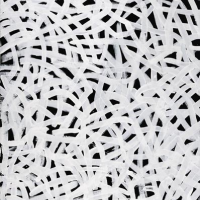42. EMILY KAME KNGWARREYE

Emily Kame Kngwarreye began creating art when she was in her late seventies. Many of these early works, produced when she was working with the Utopia Womens Batik Group from 1977 to 1988, were batiks, a medium that lends itself to the wriggling line work that was to later characterise her paintings such as the 1994 Bush Yam Dreaming. Kngwarreye did not exhibit her first acrylic paintings on canvas until 1988-89. Despite her late start as a painter on canvas the breadth of meaning inherent in her landscapes indicates one who had full knowledge of her country and the ceremonies and designs celebrating it, prior to the act of putting brush to canvas. As a custodian of her sacred country these works often focus on what seems like the minutia of the desert country but through their wonderfully evocative abstract designs they have the ability to conjure up vastness, what the artist herself referred to as the whole lot. This ability to evoke depth of meaning came from the artists traditional upbringing.
Born at Alhalkere, in the region given the name Utopia by European settlers, about 250 kilometres north-east of Alice Springs on the eastern perimeter of the Western Desert, Kngwarreye was raised in the traditional way of a desert dweller. Drawing upon traditions that had existed for thousands of years, Kngwarreye and the other women of Utopia produced unique and powerful batiks that were essentially the designs that they had used in ceremonies to decorate bodies and objects. When, in the late 1980s, they started to paint on canvas these designs were incorporated into the new medium. Inspired by the possibilities of painted surfaces, some artists, Kngwarreye included, produced new and innovative interpretations of traditional patterns. In her short painting career she moved through a number of stylistic variations that ranged from fields of dots to amorphous areas of colour that evoked an underlying sense of landscape as well as bold stripes drawn from the tradition of body painting. Bush Yam Dreaming is from a later period in the artists career when, inspired by body-paint designs and restricted by a decline in health, she began to work in broad, gestural brush strokes. The Bush or Pencil Yam (Arlatyeye) was the subject of these paintings. As a desert staple, the Arlatyeye plays a significant role in the songs, dances and ceremonies of the Eastern Anmatjerre people. Resembling action paintings these works are characterised by a complex interlacing of broad lines often in rich colours. Bush Yam Dreaming is more controlled in its layering of lines and has a subtlety imparted by its use of monochrome white on black.
Stylistically Bush Yam Dreaming anticipates the 1995 Big Yam Dreaming in the National Gallery of Victoria collection, a work that Judith Ryan, Senior Curator of Indigenous Art, described as one of the great masterpieces of our time.1 Both works share the overall design of a crisscrossing pattern of white lines on a black ground that evokes the root system of the Bush Potato within the dark earth. Demonstrating the diversity of expression that, in the hands of a supremely creative artist, can be achieved from such a simple design the greater density of overlapping lines that characterises Bush Yam Dreaming as compared to the open weave of Big Yam Dreaming gives the former work more sense of depth, as if one were looking at the root patterning deep within the earth, rather than the pattern that appears at the surface.
Kngwarreyes first solo exhibition of paintings was in 1990 at Coventry Gallery, Sydney. It received immediate critical success. In 1992 she was awarded the Australian Federal Governments Australian Artists Creative Fellowship. In the same period, public galleries began to collect her work and she is now represented in all major public collections. In 1997, a year after her death, her work was included as part of Australias contribution to the Venice Biennale and in 1998 the Art Gallery of Queensland curated a retrospective of her paintings that travelled to the Art Gallery of New South Wales and the National Gallery of Victoria. Demonstrating the international status of this artist a major retrospective of her works organised by the National Museum of Australia and the National Museum of Art in Osaka, toured Japan where it was met with critical success. The exhibition was the largest collection of works by a single Australian artist to travel outside Australia.
Footnotes
1. Ryan, J., In the beginning is my end: The Singular Art of Emily Kame Kngwarreye in Jenny Zimmer, Emily Kame Kngwarreye: Alhalkere, Paintings from Utopia, Queensland Art Gallery, Brisbane, 1998, p.45
Dr. Gary Hickey Grad Dip SUT; Fellowship RMIT, MA Melb.; PhD UQ